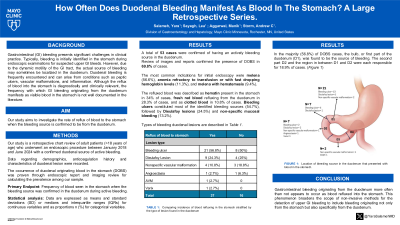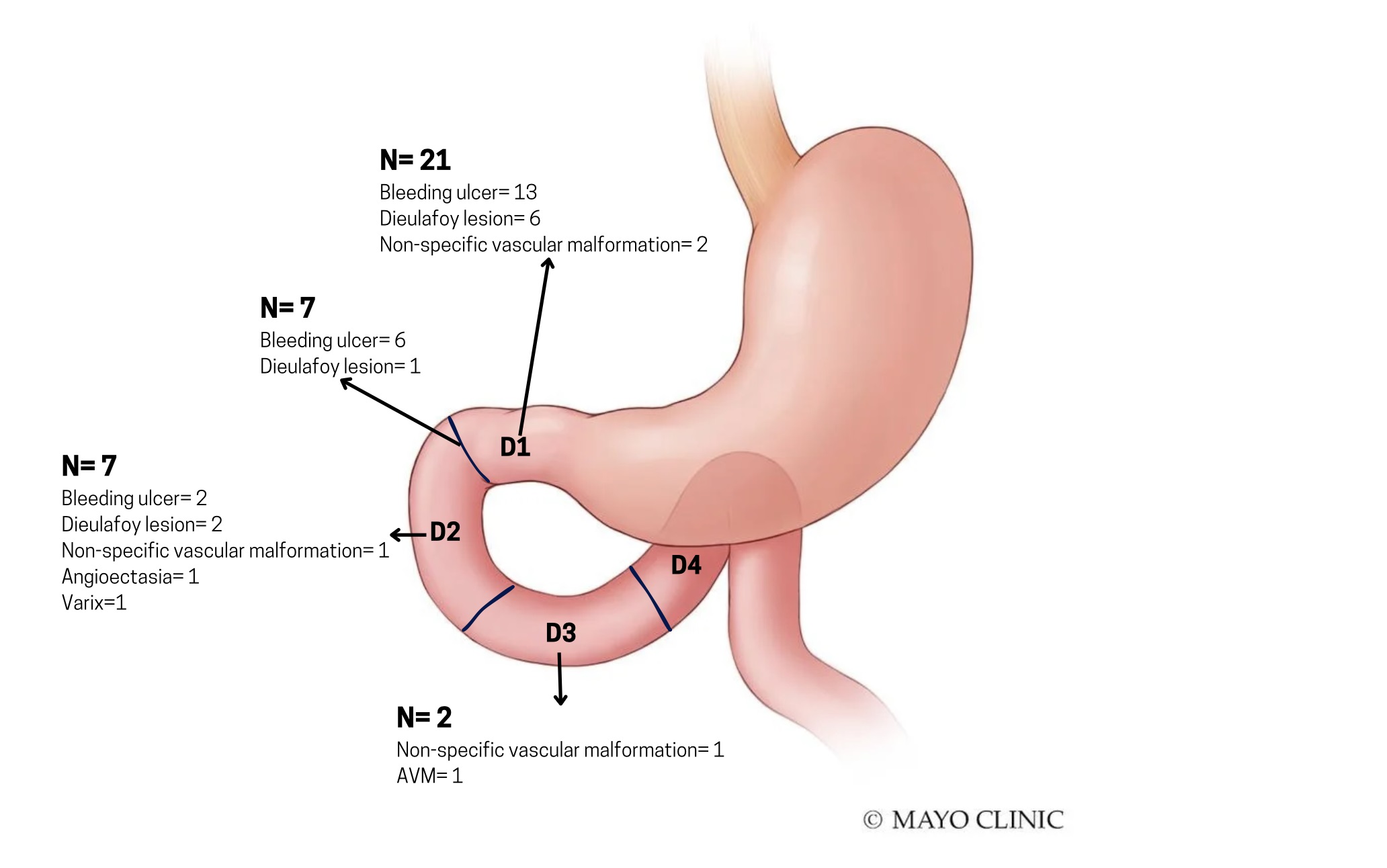Monday Poster Session
Category: GI Bleeding
P2457 - How Often Does Duodenal Bleeding Manifest as Blood in the Stomach? A Large Retrospective Series
Monday, October 28, 2024
10:30 AM - 4:00 PM ET
Location: Exhibit Hall E

Has Audio

Yara Salameh, MD
Mayo Foundation for Medical Education and Research
Rochester, MN
Presenting Author(s)
Yara Salameh, MD1, Lea Sayegh, MD1, Manik Aggarwal, MBBS2, Andrew Storm, MD2
1Mayo Foundation for Medical Education and Research, Rochester, MN; 2Mayo Clinic, Rochester, MN
Introduction: Blood in the stomach may originate from intra- or extra-gastric sources. The frequency with which bleeding originating from the duodenum manifests as visible blood in the stomach is not well described.
Methods: A retrospective chart review of adult patients ( >18 years of age) who underwent an endoscopic procedure between January 2018 and June 2024 with a confirmed duodenal source of bleeding. Data regarding demographics, anticoagulation history and characteristics of duodenal lesion were recorded. The occurrence of duodenal originating blood in the stomach (DOBS) was recorded through endoscopic report and imaging review for calculation of prevalence among our sample.
Results: Amongst the 53 cases with a duodenal source of bleeding, 37 cases were found to have DOBS. The most common indications for initial endoscopy were melena (56.6%), anemia refractory to transfusion or with fast dropping hemoglobin levels (11.3%), and melena with hematemesis (9.4%). Review of images and reports confirmed the presence of DOBS in 69.8% of cases. The refluxed blood was described as hematin present in the stomach in 34% of cases, fresh red blood refluxing from the duodenum in 28.3% of cases, and as clotted blood in 10.8% of cases. Bleeding ulcers constituted most of the identified bleeding sources (54.7%), followed by Dieulafoy lesions (24.5%) and non-specific mucosal bleeding (13.2%). In the majority (56.8%) of DOBS cases, the bulb, or first part of the duodenum (D1), was found to be the source of bleeding. The second part D2 and the region in between D1 and D2 were each responsible for 18.9% of cases. The remaining 5.4% of bleeding sources were found in D3.
Discussion: Gastrointestinal bleeding originating from the duodenum more often than not appears to occur with blood refluxed into the stomach. This phenomenon broadens the scope of non-invasive methods for the detection of upper GI bleeding to include bleeding originating not only from the stomach but also specifically from the duodenum.

Note: The table for this abstract can be viewed in the ePoster Gallery section of the ACG 2024 ePoster Site or in The American Journal of Gastroenterology's abstract supplement issue, both of which will be available starting October 27, 2024.
Disclosures:
Yara Salameh, MD1, Lea Sayegh, MD1, Manik Aggarwal, MBBS2, Andrew Storm, MD2. P2457 - How Often Does Duodenal Bleeding Manifest as Blood in the Stomach? A Large Retrospective Series, ACG 2024 Annual Scientific Meeting Abstracts. Philadelphia, PA: American College of Gastroenterology.
1Mayo Foundation for Medical Education and Research, Rochester, MN; 2Mayo Clinic, Rochester, MN
Introduction: Blood in the stomach may originate from intra- or extra-gastric sources. The frequency with which bleeding originating from the duodenum manifests as visible blood in the stomach is not well described.
Methods: A retrospective chart review of adult patients ( >18 years of age) who underwent an endoscopic procedure between January 2018 and June 2024 with a confirmed duodenal source of bleeding. Data regarding demographics, anticoagulation history and characteristics of duodenal lesion were recorded. The occurrence of duodenal originating blood in the stomach (DOBS) was recorded through endoscopic report and imaging review for calculation of prevalence among our sample.
Results: Amongst the 53 cases with a duodenal source of bleeding, 37 cases were found to have DOBS. The most common indications for initial endoscopy were melena (56.6%), anemia refractory to transfusion or with fast dropping hemoglobin levels (11.3%), and melena with hematemesis (9.4%). Review of images and reports confirmed the presence of DOBS in 69.8% of cases. The refluxed blood was described as hematin present in the stomach in 34% of cases, fresh red blood refluxing from the duodenum in 28.3% of cases, and as clotted blood in 10.8% of cases. Bleeding ulcers constituted most of the identified bleeding sources (54.7%), followed by Dieulafoy lesions (24.5%) and non-specific mucosal bleeding (13.2%). In the majority (56.8%) of DOBS cases, the bulb, or first part of the duodenum (D1), was found to be the source of bleeding. The second part D2 and the region in between D1 and D2 were each responsible for 18.9% of cases. The remaining 5.4% of bleeding sources were found in D3.
Discussion: Gastrointestinal bleeding originating from the duodenum more often than not appears to occur with blood refluxed into the stomach. This phenomenon broadens the scope of non-invasive methods for the detection of upper GI bleeding to include bleeding originating not only from the stomach but also specifically from the duodenum.

Figure: Location of bleeding source in the duodenum that presented with blood in the stomach.
AVM= Arteriovenous malformation
AVM= Arteriovenous malformation
Note: The table for this abstract can be viewed in the ePoster Gallery section of the ACG 2024 ePoster Site or in The American Journal of Gastroenterology's abstract supplement issue, both of which will be available starting October 27, 2024.
Disclosures:
Yara Salameh indicated no relevant financial relationships.
Lea Sayegh indicated no relevant financial relationships.
Manik Aggarwal indicated no relevant financial relationships.
Andrew Storm: Apollo Endosurgery – Consultant, Grant/Research Support. Boston Scientific – Consultant, Grant/Research Support. Enterasense – Grant/Research Support. Intuitive Surgical – Consultant. Olympus – Consultant. SofTac – Grant/Research Support.
Yara Salameh, MD1, Lea Sayegh, MD1, Manik Aggarwal, MBBS2, Andrew Storm, MD2. P2457 - How Often Does Duodenal Bleeding Manifest as Blood in the Stomach? A Large Retrospective Series, ACG 2024 Annual Scientific Meeting Abstracts. Philadelphia, PA: American College of Gastroenterology.
